I suspect that all of these will be less convincing to buyers than more fundamental hardware. On our review unit, this includes booming speakers and a gorgeous 1440p display that works at an impressive 240Hz. But I’m getting ahead of myself. The Scar nails the fundamentals to a degree that its flashy extras, for better and for worse, fade into the background while using it. It’s a decent choice among its competition provided you can look past a few eccentric design and software choices.
Specs and features
The review unit Asus sent us is around the middle of the pack in terms of the ROG Strix Scar’s available configurations, which is fairly contemporary with other high-end gaming laptops. The latest Intel Core i9 12900H, the above-average RTX 3070 Ti graphics card, and a generous 32GB of speedy DDR5 memory round out the internals. They’re all driving a speedy 240Hz 1440p display. But if you’re looking for a webcam, keep looking: this model simply doesn’t have one.
- CPU: Intel Core i9 12900H (6P, 8E cores)
- RAM: 32GB DDR5-4800
- GPU: Nvidia RTX 3070 Ti
- Screen: 15.6-inch LCD, 16:9, 1440p with 240Hz refresh
- Storage: 1TB PCIe 4.0 SSD
- Networking: Wi-Fi 6E, 2.5G Ethernet
- Size and weight: 13.94(W) x 10.2(D) x 1.07(H) inches, 5.07 lbs plus 1.9 lbs power brick
- Battery size: 90Wh
- Ports: Two USB 3.2 Gen 1 Type A, One USB 3.2 Gen 2 Type C, one Thunderbolt 4 (with power delivery), full HDMI 2.1, Ethernet, headset jack, DC-in
- Price: $2,499.99
Design and Build
From its asymmetrical livery to its massive, sinister RGB glowing logo and semi-translucent keyboard deck, the Scar is an unabashed gaming laptop. And it should be: at $2500 retail, which is nowhere near the most expensive version, our review unit sits firmly in the higher tier of gaming laptop hardware.
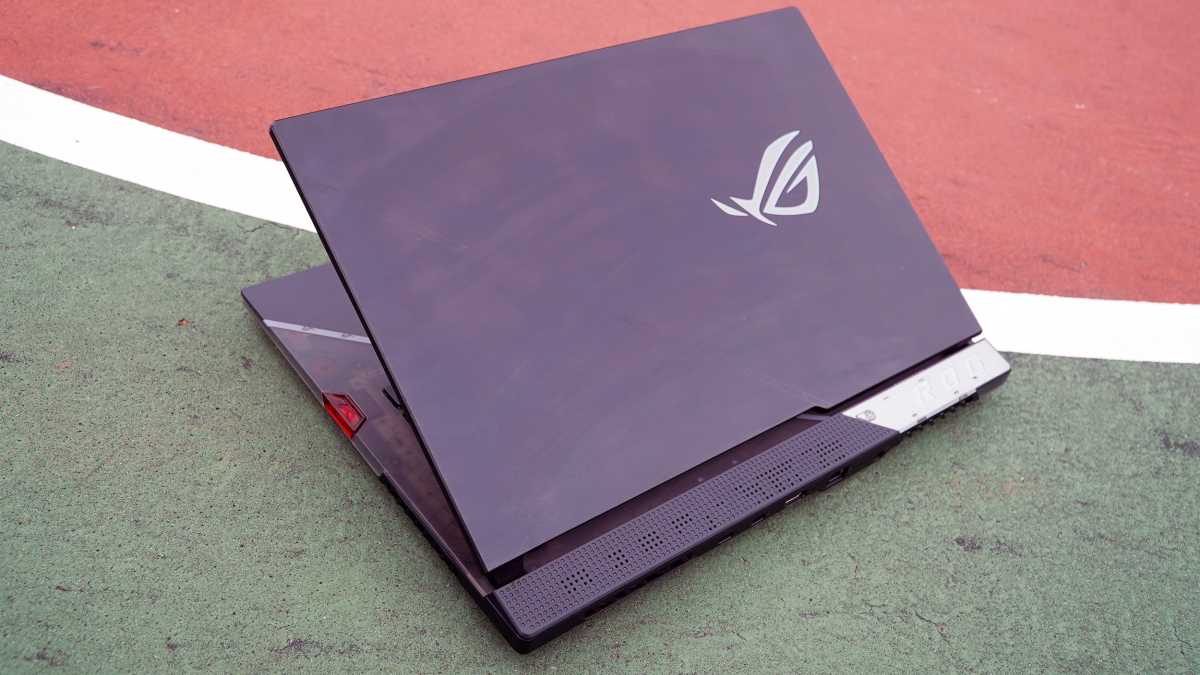
Michael Crider/IDG
The Scar isn’t understated in any way and that includes its dimensions. At more than an inch thick and a hair over five pounds, it’s among the biggest and heaviest 15-inch machines even in the gaming category. That trade-off enables it to have a massive cooling system (with exhaust on three sides!), seven different RGB lighting zones on top of the keyboard, bassy speakers, and access to the best available hardware on the market.
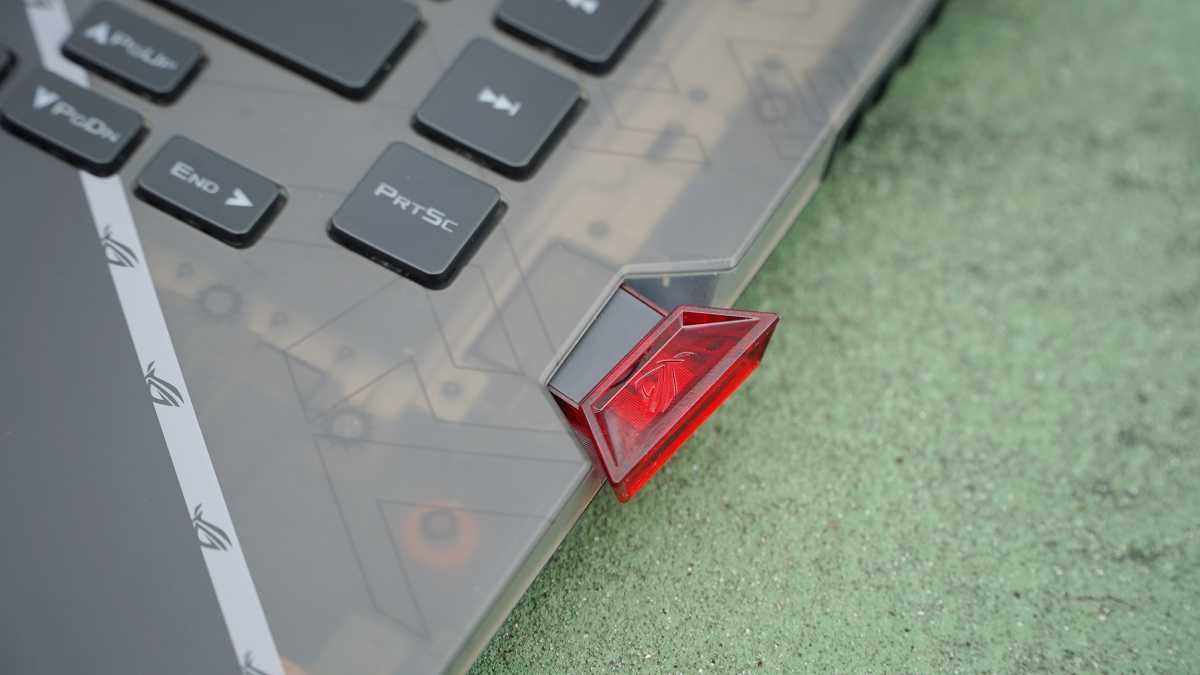
Michael Crider/IDG
Another distinctive physical element is the Keystone. This is a separate USB-based key with a proprietary connection that you can bind to a variety of functions. You can launch specific apps when it’s inserted or automatically lock the laptop when it’s removed. It’s even possible to tie access to a semi-secret file folder… though since this is bound to Asus’ proprietary Armoury Crate system, its utility is limited. The Keystone is visually interesting, but its actual usefulness is limited to saving a few keystrokes unless you happen to have another Asus machine with a Keystone port. And what kind of gamer is likely to have two such machines in the same home?
The Scar also includes two extra faceplates for the large “ROG” section of the hinge in the box, giving you a choice of matte black, silver, and translucent, the latter matching the right side of the keyboard deck. It’s a nice touch, but entirely decorative. I would have liked to have seen a red option to match the distinctive accent of the Keystone.
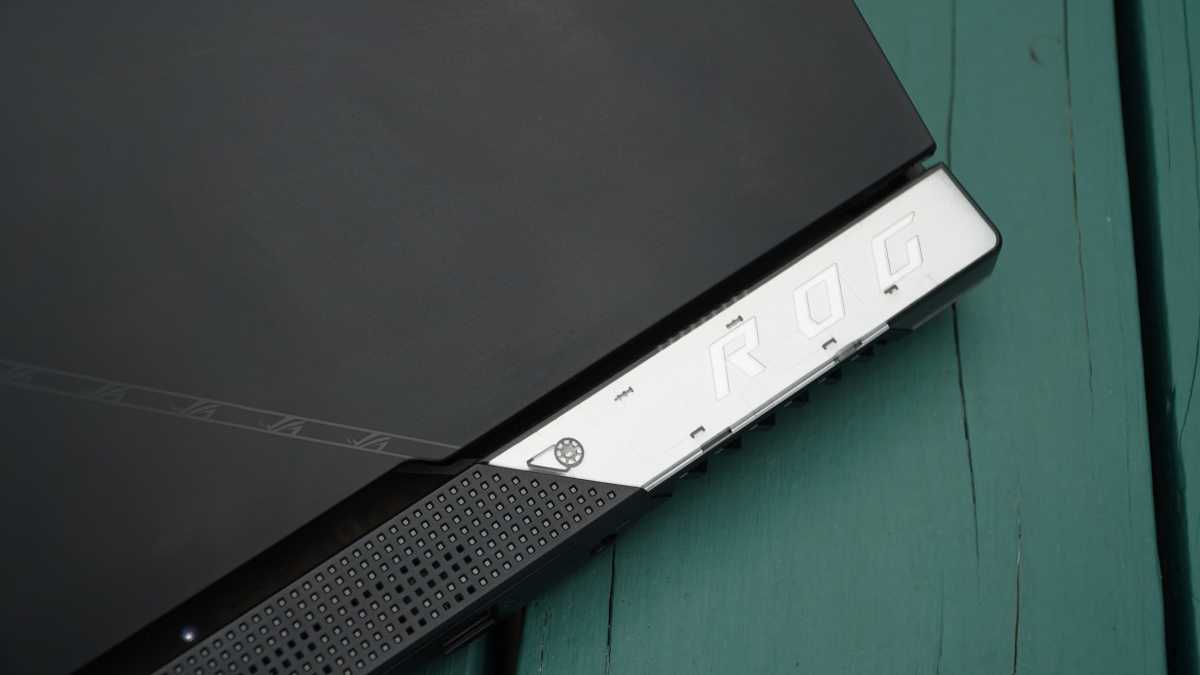
Michael Crider/IDG
Despite its large stature, the Scar feels solid and evenly weighted. Significant flex on its skinny screen is a point of concern, but it feels safe enough when closed that traveling isn’t a problem. The gap in the hinge allows for pleasant use of those booming speakers, too. The only other significant complaint I have is the positioning of the exhaust ports. When in full, glorious gaming mode, the side fans are surprisingly quiet, but they will blast your hand with hot air if you’re using a mouse on either the left or right side.
Oh, and that huge build isn’t helped by a massive power brick. “Brick” is barely an exaggeration here: the 280-watt adapter is seven inches long without the cables and a pound and a half all on its own. Fortunately the laptop can be charged (very slowly) via USB-C.
Keyboard and Trackpad
The Scar’s keyboard isn’t particularly amazing or poor. It’s a conventional membrane design, despite the generous dimensions of the laptop, and its per-key RGB lighting is serviceable even if you’ll dread diving into the Armoury Crate program to adjust it. The touchpad is big, wide, and perfectly centered, great for getting around the high-res screen in comfort when you’re without a mouse.
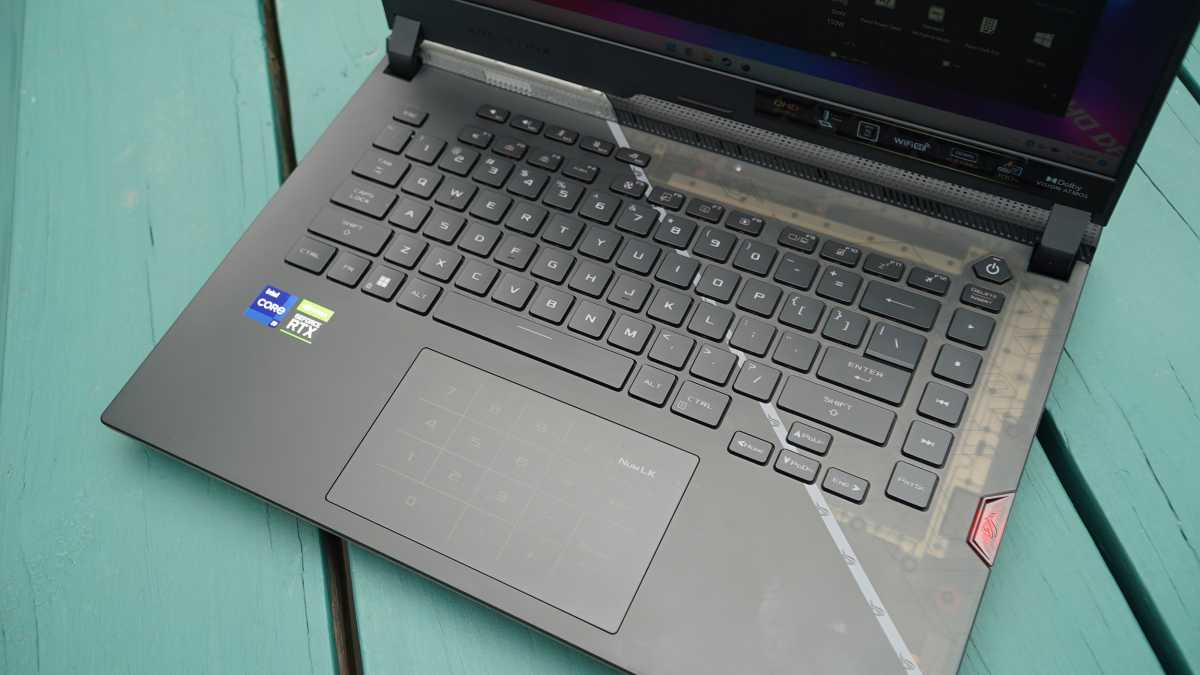
Michael Crider/IDG
Despite the large size, Asus places the 10-key area as a conditional function of the touchpad, enabled by long-pressing the discrete NumLK sign. While I don’t particularly miss the physical keys, I doubt anyone who actually cares about having a 10-key area will prefer this solution, which lacks tactile response for rapid data entry. This is a more specific choice on a large gaming laptop that could have fit a full keyboard, as opposed to the slinky Zenbooks where it originated.
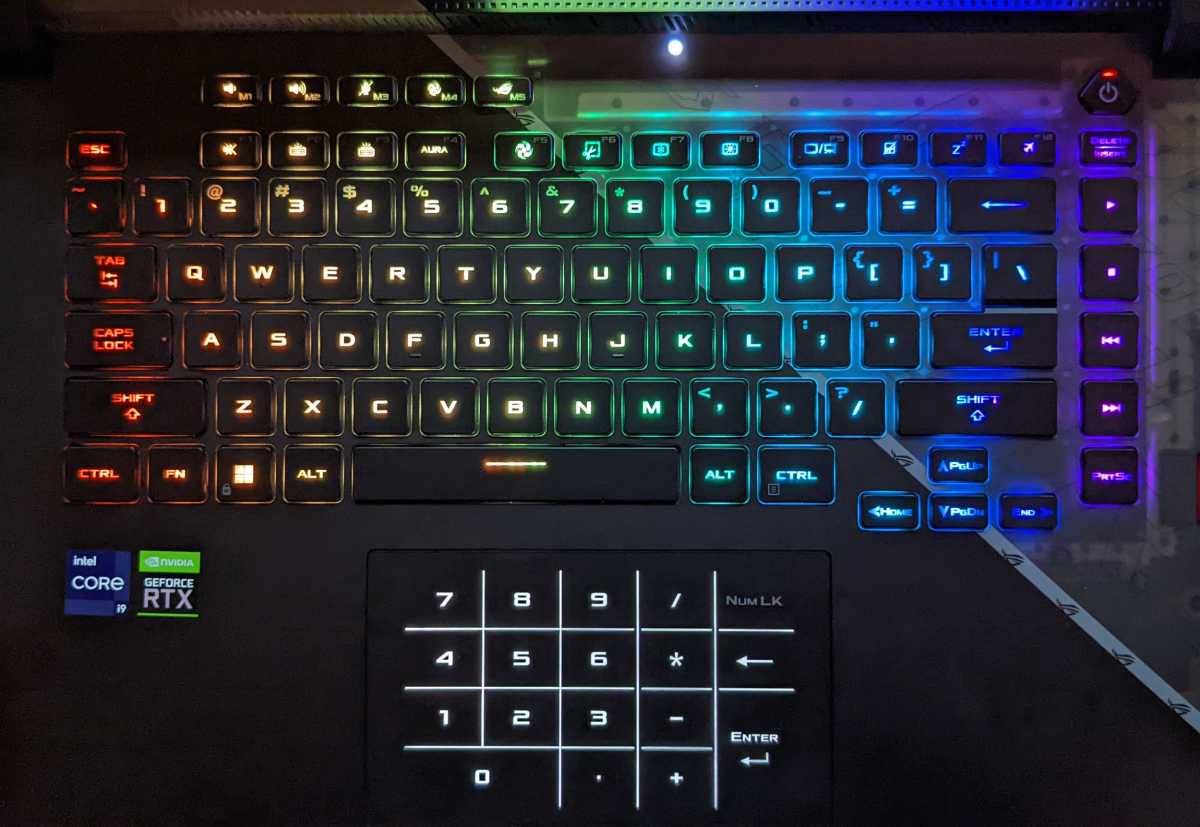
Michael Crider/IDG
Despite the omission of a 10-key, there are dedicated media buttons and a few extras for easily managing the laptop. One-button access to a microphone mute, fan speed modes, and Armoury Crate is an intelligent use of the space available. I generally liked the half-translucent visual design of the keyboard deck itself (very distinctive!), but could have done without a constantly-flashing disk read light right below the screen.
Display
The Scar’s screen doesn’t do anything too out of the ordinary, but it’s a highlight of the design nonetheless. Our review unit came with a 2560×1440 IPS panel with a refresh rate of 240Hz (300Hz is available if you’re okay with 1080p). The colors are accurate and shockingly bright for an IPS panel, made all the more striking by a 4mm bezel on three sides. A small amount of shadow is visible in the lower corners.
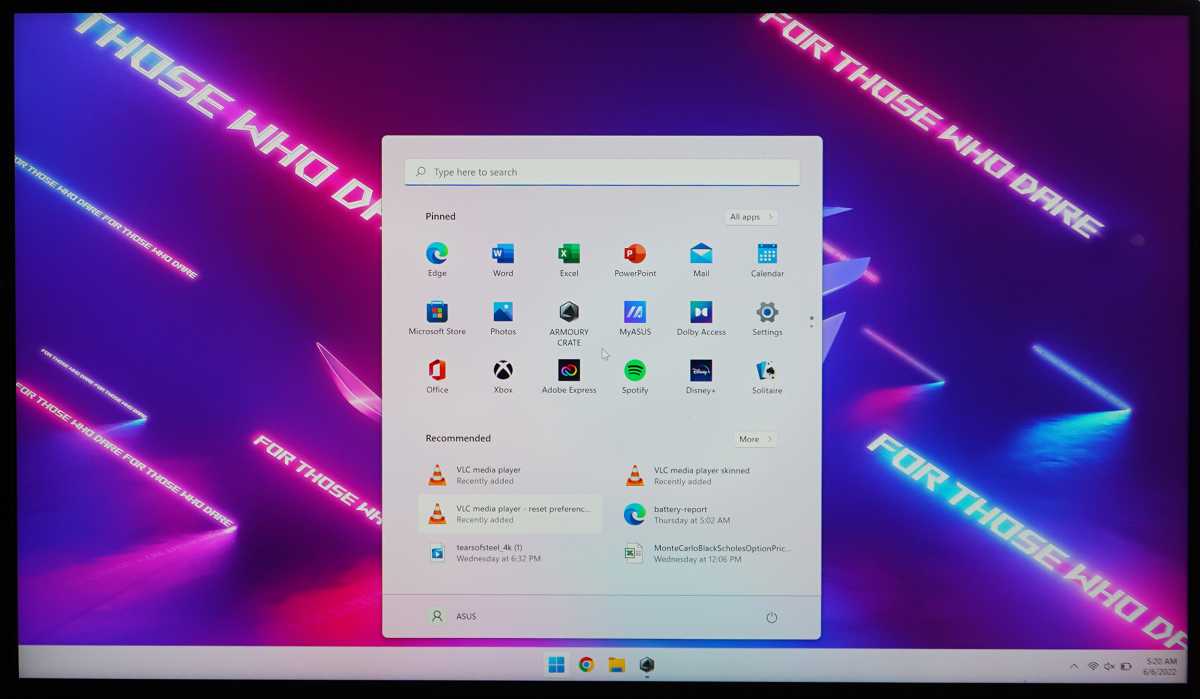
Michael Crider/IDG
Given the choice, I’d go with the higher resolution and lower refresh rate every time. Not only will games look better, but you’ll be able to do more conventional work in Windows and really take advantage of the physical space. Aspiring e-sports competitors will disagree with me, of course.
While it won’t dethrone an OLED panel, the screen on the Scar is impressive enough that it might just sell the machine for you in comparison to other models.


.jpeg)

Nice
ReplyDelete